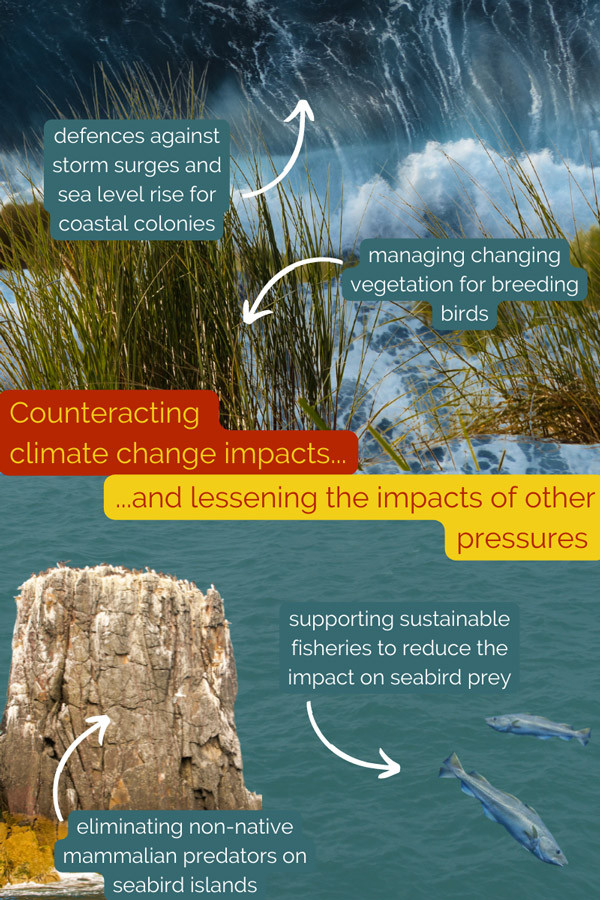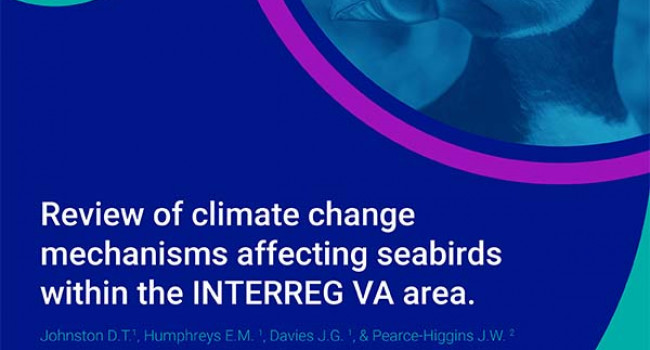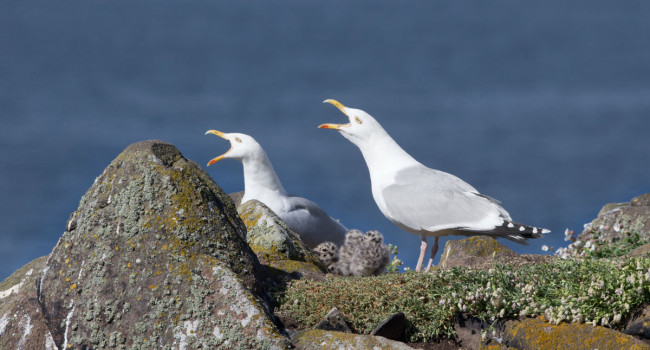Understanding the impacts of climate change on seabirds

This case study describes a range of research on climate change and seabirds undertaken through the MarPAMM project, supported by the European Union’s INTERREG Programme, collaborative with RSPB and overseen by Agri-Food and Biosciences Institute and Marine Scotland.
Although the MarPAMM project was focused on the INTERREG VA region covering the seas between the west coast of Scotland, Northern Ireland and the Republic of Ireland, our study included data from across Great Britain and Ireland, and the associated seabird colonies.
Figure: Map displaying the study area, with INTERREG VA (yellow) and MarPAMM management regions (blue, Outer Hebrides; black, Argyll; purple, Co. Down – Co. Louth; green, North Coast Ireland – North Channel)
Investigating current impacts of climate change on seabird populations
The first component of the work was a review of the evidence that climate change is already affecting our seabirds, and particularly highlighted the mechanisms that underlie those responses. A total of 156 studies were included in the review, which were synthesised into accounts for individual species or species groups. Some clear patterns emerged.
Most studies identified strong evidence linking long-term oceanographic and climatic changes to seabird populations.
The majority of studies considered the indirect impacts of climate change on seabird populations (including on survival rates and breeding success), and identified strong evidence linking long-term oceanographic and climatic changes to seabird populations. In particular, increases in seawater temperature drive a cascade of changes through the food chain that ultimately affect the amount of food available, particularly around colonies for breeding seabirds. A smaller number of short-term studies highlighted more direct impacts of particular extreme weather events in seabird populations, such as large-scale breeding failure or mass mortality (wrecks) during the winter.
Responses to climate change differed between species. While long-ranging species such as Northern Fulmar were influenced by large-scale climatic factors, species with more restricted ranges such as Shag were more sensitive to localised weather conditions. Responses were also linked to foraging behaviour; surface-foragers such as Black-legged Kittiwake were most sensitive to variation in prey abundance, but diving species like Common Guillemot were more sensitive to poor weather impacting their ability to forage. Variation in diet also affected sensitivity to different mechanisms; populations feeding on sand eels appear more sensitive to reduced prey availability due to warming seas, for example. More studies of diet and impacts on seabird populations are required in the MarPAMM region.
Fulmar Fulmarus glacialis
(Projected decline of 65.4% by 2050)
Major contributors to decline: adverse weather conditions related to the changes in Atlantic pressure patterns affect the birds' ability to forage and provide food for chicks.
Birds of Conservation Concern UK: Amber-listed
IUCN European Red List: Vulnerable
Figure: Projected change (1998-2002 to 2050) in Fulmar breeding pairs, for all areas where Fulmar was present in 1998-2002. Blue = increase, red = decrease. Black polygon = INTERREG VA area
More about impacts on Fulmar
Fulmars are long-range surface foragers and migratory, so are mainly affected by climatic factors covering broad spatial areas. A large number of studies have shown that Fulmar foraging behaviour and ability are impacted by changes in the North Atlantic Oscillation (NAO) index, a measure of the difference in pressure between two key pressure patterns over the Atlantic: a low-pressure pattern near Iceland and a high-pressure pattern near the Azores. This in turn affects the food available for chicks, altering breeding productivity (the number of chicks raised successfully every year). A small number of studies have also found links between Sea Surface Temperature (SST) changes and Fulmar breeding productivity.
Line thickness represents the relative number of studies which have found significant relationships between the components. Thicker lines indicate more studies with significant results.
How might seabird populations change in the future?
In the second phase of the work, we used previous seabird census data (Seabird Colony Register 1985-88 and Seabird 2000 1998-2002) to model the abundance of breeding seabirds across Great Britain and Ireland through time. By relating seabird counts to measures of climate and oceanography, we were able to project future changes in abundance using a RCP8.5 (high climate change business-as-usual) scenario to 2050. Of the 25 species we studied, we were able to produce projections for 19 (for six species there were not adequate data). Typically, increased breeding season temperature and winter precipitation were associated with decreased species abundance, and the relationship between abundance and the sea-surface temperature during the breeding season was dependent on foraging behaviour.
The majority of species were projected to decline in abundance by 2050.
The majority of species (14) were projected to decline in abundance by 2050, with Arctic Skua and Storm Petrel at the greatest risk of extinction within the INTERREG VA region. Fulmar, Arctic tern, Little Tern, and Sandwich Tern were all projected to decline by more than 50%, and in the case of Puffin, by more than 90%. Conversely, Shag, Black-headed Gull and Lesser Black-backed Gull were all projected to increase by more than 50% across the region. Overall, 11 species were regarded as having a high vulnerability to climate change, while only four species were identified as having a potential opportunity to increase in response to climate change. This work contributed strongly to the recent BTO report on Climate Change and the UK’s birds, which highlighted the high vulnerability of seabirds to climate change.
Puffin Fratercula arctica
(Projected decline of 93.1% by 2050)
Major contributors to decline: changes in sea surface temperature and pressure patterns in the Atlantic are affecting prey, which in turn impacts the number of chicks surviving and the timing of breeding.
Birds of Conservation Concern UK: Red-listed
IUCN European Red List: Endangered
Figure: Projected change (1998-2002 to 2050) in Puffin breeding pairs, for all areas where Puffin was present in 1998-2002. Blue = increase, red = decrease. Black polygon = INTERREG VA are
More about impacts on Puffin
Puffins are primarily affected by changes in Sea Surface Temperatures (SST) and the North Atlantic Oscillation (NAO) index, a measure of the difference in pressure between two key pressure patterns over the Atlantic: a low-pressure pattern near Iceland and a high-pressure pattern near the Azores. A number of studies have found links between these climatic factors and plankton phenology (the timing of their lifecycle), abundance and composition (the number and proportion of different species present). These changes to plankton populations are linked to altered Puffin prey abundance, which impacts the birds' ability to feed their chicks and in turn affects breeding productivity (the number of chicks raised each year). Changes in prey abundance and availability also impact the Puffin's breeding date and adult mortality, reducing the survival of adult birds and altering Puffin phenology.
ETC: Extra-tropical cyclones, which can cause extreme winds, precipitation and fluctuating temperatures
NHT: Northern Hemisphere Temperature anomaly, a measure of the degree to which a date's temperature deviates from the mean recorded temperature for that date.
Line thickness represents the relative number of studies which have found significant relationships between the components. Thicker lines indicate more studies with significant results.
How might seabird distributions change in the future?
The third element of the work was led by RSPB and, using habitat modelling, aimed to predict how breeding seabird distributions would be altered under future climate change projections. There were two main mechanisms by which climate change could impact species distribution. Firstly, distributions could be altered by the impacts of climate change on colony size and resulting impacts on density-dependent competition between colonies. Secondly, environmental changes could alter projected changes in the usage of different foraging areas. Of these, changes in colony size had the greatest impact on predicted at-sea distributions, with the highest densities of birds predicted within the vicinity of the largest breeding colonies. This information can help inform how marine conservation strategies should adjust to a rapidly changing environment.
The projected impacts of climate change are available via the MarPAMM website, as well as summaries for different regions of the INTERREG VA region.
Shag Phalacrocorax aristotelis
(Projected increase of 51.6% by 2050)
Major contributors to trends: adverse changes in wind and rain conditions cause hypothermia in adult birds and nest failure. Changes in sea surface temperature also negatively impact prey, decreasing the amount of food available for chicks and changing the timing of breeding.
Birds of Conservation Concern UK: Red-listed
IUCN European Red List: Least Concern
Figure: Projected change (1998-2002 to 2050) in Shag breeding pairs, for all areas where Shag was present in 1998-2002. Blue = increase, red = decrease. Black polygon = INTERREG VA area
More about impacts on Shag
Shags are more locally migratory, meaning they are more strongly impacted by small-scale climatic factors, such as wind, rain and Sea Surface Temperature (SST), than broad-scale factors like the North Atlantic Oscillation (NAO) index. As well as affecting prey abundance with resulting 'knock-on' effects for adult and chick survival, these small-scale factors also impact Shags directly. With only partially waterproof feathers, adult birds can suffer hypothermia in strong winds and rain, decreasing the number of individuals which survive each year. Young birds in nests experience higher rates of mortality in extreme weather too. However, across the INTERREG VA region, Shags are predicted to increase over the coming years, largely due to shifts in habitat suitability which could potentially lead to an increase in Shag distribution.
TAI: Temperature Anomaly Index
Line thickness represents the relative number of studies which have found significant relationships between the components. Thicker lines indicate more studies with significant results.
Helping seabirds cope with climate change
The final element of the work was to consider suggestions for climate change adaptation options for seabirds, given the growing evidence for conservation management’s potential to help biodiversity adapt to climate change (Bowgen et al. 2022).

Building on the literature review and projected vulnerability to climate change from the earlier stages of the assessment, we summarised the potential mechanisms by which different seabird habitats may be affected by climate change. We used this summary to develop a list of adaptation options bespoke to each habitat, and divided these into two categories.
Firstly, we could deploy options aiming to counteract specific mechanisms by which climate change might impact habitats. For example, to counteract increasing sea levels and storm surge frequency, we could manage sea defences to protect low-lying coastal seabird colonies. Similarly, if climate change alters the vegetation composition and structure at seabird colonies, this could be managed to reduce the impact on breeding birds. Secondly, we could utilise compensatory options which would work more broadly to support species affected by climate change, such as eliminating non-native mammalian predators on seabird islands, and encouraging sustainable fisheries management which avoids reducing fish stocks.
This collective information will inform the future conservation of seabirds.
In combination, this collective information will inform the future conservation of seabirds within the INTERREG project area, but more widely across Great Britain and Ireland, and beyond. We have identified the main mechanisms by which climate change affects different seabird species, identified which species are likely to be most vulnerable to future climate change, and suggested a range of different adaptation options for conservation managers to consider as they develop management plans. Finally, this assessment relies upon the ongoing collection of long-term monitoring data to track the impacts of climate change and to measure responses to conservation interventions, which can be particularly challenging in the context of climate change adaptation (Pearce-Higgins et al. 2022). It is for this reason, recognising the international responsibility we have in the UK for seabird conservation and their potential vulnerability to climate change amongst other threats, that BTO is prioritising better supporting seabird monitoring and taking on leadership of the Seabird Monitoring Programme.
This project has been supported by the EU's INTERREG VA Programme, managed by the Special EU Programmes Body. The views and opinions expressed in this article do not necessarily reflect those of the European Commission or the Special EU Programmes Body (SEUPB).

Avian Influenza Appeal
Our seabirds now face yet another threat: the 2021/22 outbreak of Highly Pathogenic Avian Influenza (HPAI), which spread into their colonies and caused devastating levels of mortality. We need your support if we are to help these populations recover.
Donate today






















Share this page